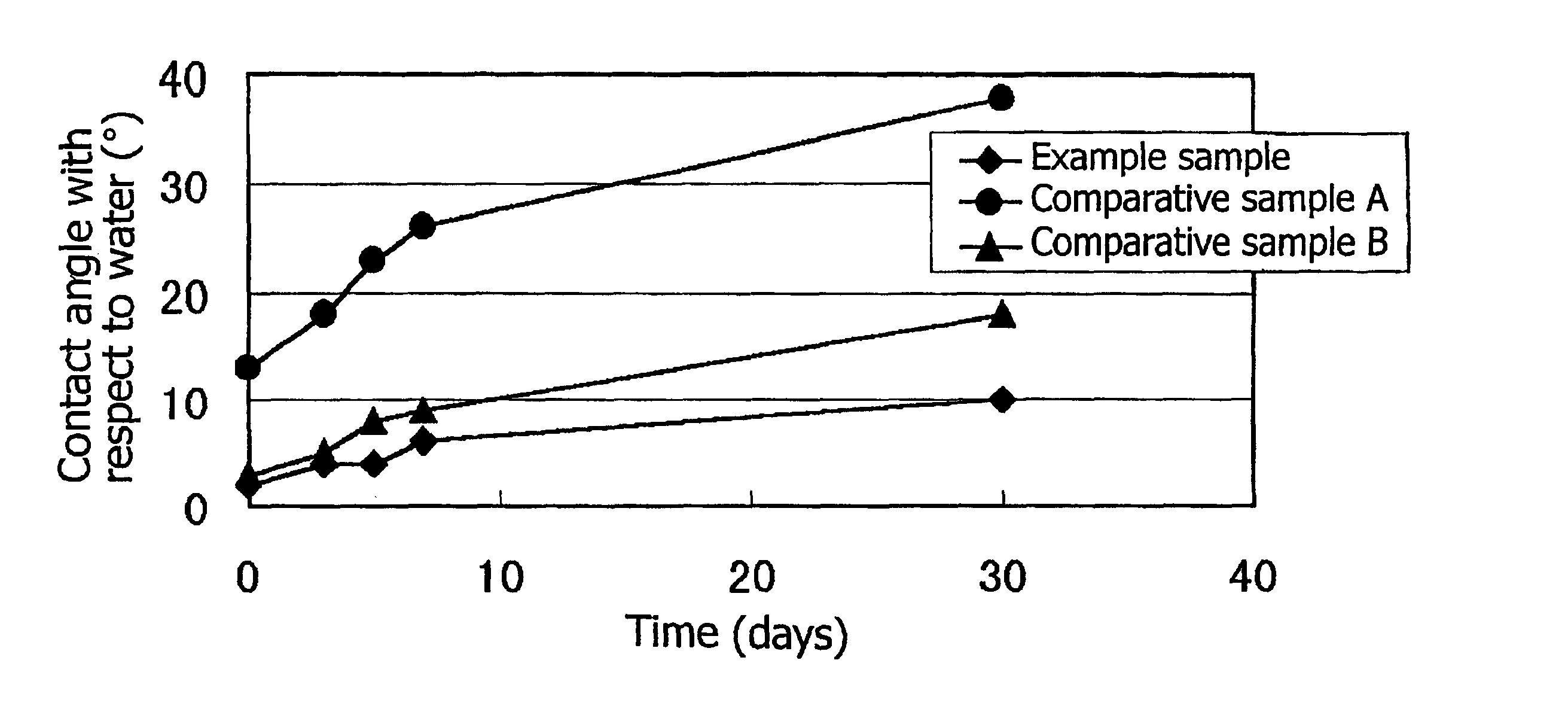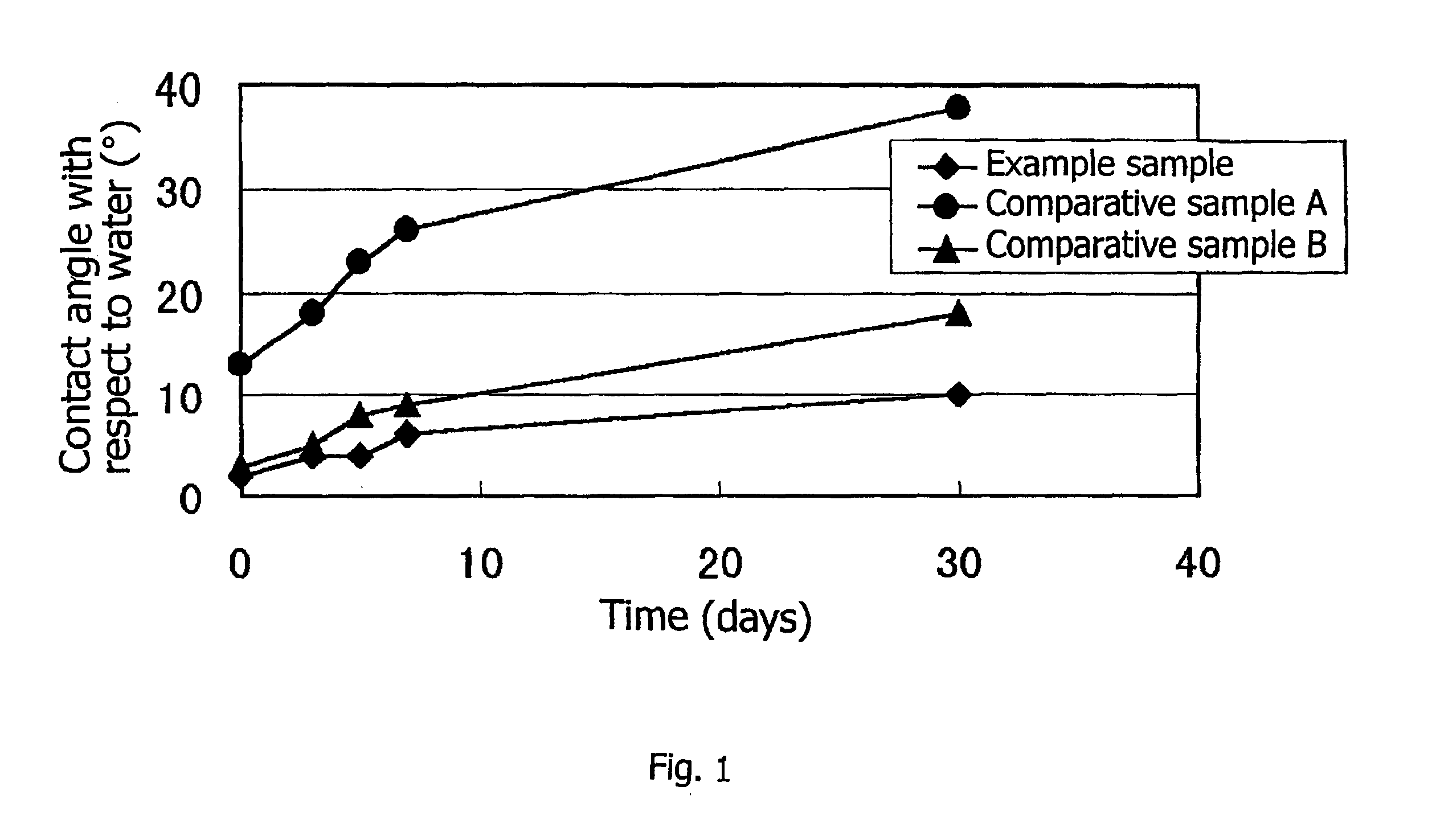Photo-functional powder and applications thereof
a technology of photofunctional powder and powder, applied in the field of materials, can solve the problems of harmful organic substances or environmental contaminants, and achieve the effect of excellent dispersion stability and excellent industrial applicability
- Summary
- Abstract
- Description
- Claims
- Application Information
AI Technical Summary
Benefits of technology
Problems solved by technology
Method used
Image
Examples
example 1
[0041]Pure water (50 liters) (hereinafter the term “liter(s)” will be referred to as simply “L”)—which had been weighed in advance—was heated to 98° C. with stirring and maintained at this temperature. A titanium tetrachloride aqueous solution (Ti concentration: 15 mass %) (product of Sumitomo Sitix of Amagasaki, Inc.) (3.6 kg) was added dropwise to the heated water over 60 minutes. The thus-obtained white suspension was subjected to dialysis by use of an electric dialyzer, to thereby adjust the pH of the suspension to 5. A portion of the thus-obtained photocatalytic slurry was collected, and the solid content was measured by means of a dry constant weight method and found to be 2 mass %. The solid (dried powder) was subjected to structure analysis by use of an X-ray diffraction apparatus. As a result, the powder was found to be of brookite-type titanium dioxide containing brookite-type crystals in an amount of 80%.
[0042]Subsequently, sodium metaphosphate (for food addition, product...
example 2
[0049]The coating agent containing the photo-functional powder and urethane resin obtained in Example 1 was applied to one surface of a polyethylene terephthalate film (Lumilar T, product of Toray Industries, Inc.) (thickness: 100 μm) by use of a 25-μm applicator, and then dried at 80° C. for two hours, to thereby obtain a polyethylene terephthalate film having the photo-functional powder supported thereon.
[0050]The thus-obtained polyethylene terephthalate film (surface area: 600 cm2) was subjected to photocatalytic activity evaluation and weather resistance testing in a manner similar to that in Example 1. The photo-functional-powder-bearing polyethylene terephthalate film was subjected to measurement of transmittance by use of a spectrophotometer (UV-2400PC, product of Shimadzu Corporation). As a result, the transmittances at 360 nm and 550 nm were found to be 5% and 98%, respectively. The results are shown in Table 1.
example 3
[0051]A portion of the photo-functional slurry obtained in Example 1 was dried by use of a medium fluidized drier (Slurry Drier, product of Okawara Mfg. Co., Ltd.), to thereby prepare a photo-functional powder (5 kg) having a calcium-containing condensed phosphate on the surface of titanium dioxide fine particles.
Preparation of High-Density Polyethylene Masterbatch
[0052]The above-prepared photo-functional powder (20 parts by mass), zinc stearate (Zinc Stearate S, product of NOF Corporation) (2 parts by mass), and high-density polyethylene (Jrex F6200FD, product of Japan Polyolefins Co., Ltd.) (78 parts by mass) were melt-kneaded at 170° C. (residence time: about three minutes) by use of a twin-screw extruder (model: PCM30, product of Ikegai Iron Works, Ltd.), and the resultant product was pelletized, to thereby obtain a high-density polyethylene masterbatch (compound) (20 kg) containing a columnar photo-functional powder in an amount of 20%, each powder particle having a diameter of...
PUM
| Property | Measurement | Unit |
|---|---|---|
| particle size | aaaaa | aaaaa |
| optical length | aaaaa | aaaaa |
| optical length | aaaaa | aaaaa |
Abstract
Description
Claims
Application Information
 Login to View More
Login to View More - R&D
- Intellectual Property
- Life Sciences
- Materials
- Tech Scout
- Unparalleled Data Quality
- Higher Quality Content
- 60% Fewer Hallucinations
Browse by: Latest US Patents, China's latest patents, Technical Efficacy Thesaurus, Application Domain, Technology Topic, Popular Technical Reports.
© 2025 PatSnap. All rights reserved.Legal|Privacy policy|Modern Slavery Act Transparency Statement|Sitemap|About US| Contact US: help@patsnap.com


